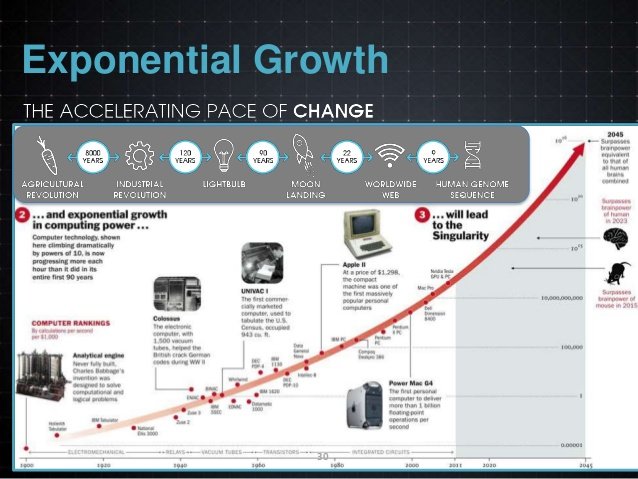Law of Accelerating Returns
In today's world, there is a sense that the life we are
experiencing appears to be moving at a faster pace as each subsequent year
passes. The acceleration of one's life
is actually occurring; it is not a mirage and has been predicted. The predictor of the acceleration of life and
the world as we know it is Raymond Kurzweil.
Raymond Kurzweil, in his 1999 book The Age of Spiritual Machines,
predicted/postulated "The Law of Accelerating Returns." He wrote in 2001 an essay titled "The Law
of Accelerating Returns," in which Raymond Kurzweil further elaborated
on his prediction through the example/lens of Moore's law. In a nutshell, the law of accelerating
returns is where progress speeds up over time in an exponential manner because
of the common force of evolution driving it forward, especially concerning
information technology
Evolution applies positive feedback
in that the more capable methods resulting from one stage of evolutionary
progress are used to create the next stage.
As a result, the rate of progress
of an evolutionary process increases exponentially over time. Over time, the
"order" of the information embedded in the evolutionary process
(i.e., the measure of how well the information fits a purpose, which in
evolution is survival) increases.
A correlate of the above
observation is that the "returns" of an evolutionary process (e.g.,
the speed, cost-effectiveness, or overall "power" of a process)
increase exponentially over time.
In another positive feedback loop,
as a particular evolutionary process (e.g., computation) becomes more effective
(e.g., cost-effective), greater resources are deployed toward the further
progress of that process. This results in a second level of exponential growth
(i.e., the rate of exponential growth itself grows exponentially).
Biological evolution is one such
evolutionary process.
Technological evolution is another
such evolutionary process. Indeed, the emergence of the first technology
creating species resulted in the new evolutionary process of technology.
Therefore, technological evolution is an outgrowth of--and a continuation
of-biological evolution.
A specific paradigm (a method or
approach to solving a problem, e.g., shrinking transistors on an integrated
circuit as an approach to making more powerful computers) provides exponential
growth until the method exhausts its potential. When this happens, a paradigm
shift (i.e., a fundamental change in the approach) occurs, which enables
exponential growth to continue (Kurzweil, 2004, p. 3).
The forecasting and prediction of the "Law of
Accelerating Returns" in an innovation context is the already mentioned example
of Moore's law, which will be some more, human genome and nanotechnology. Moore's
law only refers to integrated circuits' exponential price-performance
improvements
Computing trends in an exponential fashion and is composed
of an array of sequential S-shaped technological life cycles, called S-curves
The propensity for advances to feed on themselves,
augmenting the pace of further advancement, and exceeding what would be
calculated for a typical project linearly is demonstrated by the human genome
project. The human genome project
initially took many years to complete 1% of it, resulting in decades'
expectations to complete. Instead, it took only seven years to complete due to
improved methods (Buchanan, 2008).
Watts & Porter (1997) postulate that innovation
forecasting and prediction rely on a multitude of variables. Characteristics of the subject under
research, fit between the subject and firm/persons, the firm/person knowledge
of the market and infrastructure of the subject under study, market forces,
economic climate and resource obligations, other socio-economic factors, and
corporate actions or interactions.
References
Berman, A., & Dorrier, J. (2016, March
22). Technology Feels Like It’s Accelerating – Because It Actually Is.
Retrieved from SingularityHub:
https://singularityhub.com/2016/03/22/technology-feels-like-its-accelerating-because-it-actually-is/
Berman,
A., Dorrier, J., & Hill, D. (2016, April 5). How to Think Exponentially
and Better Predict the Future. Retrieved from SingularityHub: https://singularityhub.com/2016/04/05/how-to-think-exponentially-and-better-predict-the-future/
Buchanan, M. (2008). The law of
accelerating returns. Nature Physics, 4(7),
507-507. doi:10.1038/nphys1010
Diamandis, P. (2016, January 1). WHY
TECH IS ACCELERATING. Retrieved from Diamandis:
https://www.diamandis.com/blog/why-tech-is-accelerating
Kurzweil, R. (2004). The law of
accelerating returns. In Alan Turing:
Life and legacy of a great thinker (pp. 381-416): Springer.
Watts,
R. J., & Porter, A. L. (1997). Innovation forecasting. Technological
Forecasting and Social Change, 56(1), 25-47.


Comments
Post a Comment